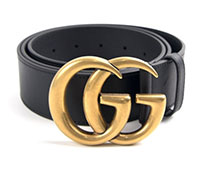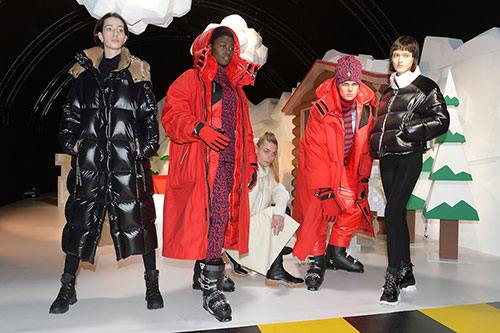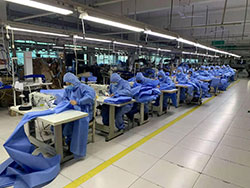FW
Women’s and girls’ jeans imports into the US have seen dramatic swings in 2019. Jeans imports from top supplier China fell 21.2 per cent while imports from Vietnam jumped 34.23 per cent. Bangladesh saw its imports inch up 0.9 per cent last year. Among the rest, increases were registered by Pakistan, Cambodia and Sri Lanka, while decreases were posted by Mexico, Egypt, Indonesia and Jordan. In dresses, imports from China decreased 7.98 per cent in 2019, with Vietnam’s shipments falling 1.79 per cent. Indonesia’s imports were flat for the year. In skirts, China’s shipments dipped 1.19 per cent for the year, as imports from Vietnam fell 3.71 per cent.
Retail apparel prices in the US rose a seasonally adjusted 0.7 per cent in January compared to December. The monthly increase was led by a 2.3 per cent hike in men’s wear, a 1.8 per cent rise in girls’ apparel and a gain of 1.2 per cent in infants’ and toddlers’ clothes, while women’s wear prices inched down 0.1 per cent and boys’ apparel sold for 5.8 per cent less.
Textile Opportunities in a changing Automotive Industry (TOAI) was held in the UK, February 5 to 6, 2020. The conference showcased the best innovations and collaborative action from automotive brand leaders and their supply chain to dramatically reduce material, production energy and process water waste. It illustrated the sheer diversity of end-use applications for textiles in the automotive industry that already exist, and the potential for further growth, both through car manufacturers seeking to lower weight to reduce CO2 emissions and the push to develop alternatives to the internal combustion engine.
Textiles and nonwovens are contributing to the new mobility era by providing, for example, textile interiors with high levels of comfort for the occupant while reducing the impact of manufacturing on the environment. New processes are offering waste-free recycled lightweight materials for interiors. With natural fibers and new materials come new benefits such as higher tensile strength, inherent heating/cooling, moisture wicking properties and anti- soiling solutions. In addition, the perception of luxury is changing, and sustainability is becoming an ever-more important factor in consumer-purchasing decisions.
New concepts and techniques were described, which sparked informative discussion during the forum sessions. There were ample networking opportunities for participants. TOAI offered valuable and interesting content and praised the high quality of the individual presentations in a well-structured program.
India’s merchandise exports fell for the sixth consecutive month in January 2020. Trade deficit has risen to a seven-month high. The increase in the January merchandise trade deficit has primarily been led by a sharp rise in crude oil imports, which will subside in February because of the correction in crude oil prices.
During the first 10 months of the current fiscal year, exports have contracted 1.9 per cent while imports have shrunk 8.1 per cent. Weakening external sector will put additional pressure on India’s fledgling economic growth, which is estimated to decelerate to an 11-year low of five per cent this year. Out of the 30 major items each in India’s export and import baskets, 21 export items and 17 imported goods witnessed contraction. While exports of readymade garments fell by five per cent, gems and jewelry dropped by 11.6 per cent and engineering goods lost four per cent during the month. However exports of pharmaceuticals, electronics goods, petroleum products and chemicals made a recovery. Among major imports, coal fell by 24.4 per cent, chemicals by 12 per cent, gold by 31.5 per cent and electronics goods shrank by 4.7 per cent. However, signaling a recovery in domestic industrial activity, imports of machinery and transport equipment rose.
Renowned tradeshow on garment textile machinery ‘Gartex Texprocess India’, held annually in New Delhi, will launch its March 2020 edition in Mumbai, owing to the demand generated by garment and textile manufacturing industry in Indian and overseas markets.
Exhibitors, who have signed up for the event, will present latest innovations, machines, plants, processes and services to various stakeholders in the industry, including manufacturers and suppliers. The show is scheduled to be held from March 19-21 2020 at the Bombay Exhibition and Convention Centre.
The highlights of the show include ‘Garmenting & Apparel Machinery’ that will provide insights on the technological developments in the garment & apparel manufacturing sector. Besides this, innovative products and technologies, defining latest trends in the industry, will be showcased to the visitors at the four concurrent shows – Denim Show, India Laundry Show, Fabrics & Trims Show and Digitex Show during the three-day event.
The event is also aimed at providing business opportunities to the international and national suppliers as well as trade visitors through networking sessions with industry experts and engaging in investment opportunities during the show.
Première Vision was held in Paris from February 11 to 13, 2020. Some exhibiting denim manufacturers offered new materials and low-impact fabrics. Among them, Prosperity presented an enlarged selection of its Stella Blu line, which offers indigo fabrics characterized by new textures, weights and end-uses. Evlox focused on Redenim, its overall offer of eco-friendly denim. Kipas Denim presented eco-friendly denim made by using organic cotton, preconsumer and postconsumer recycled denim, and eco-friendly fibers such as hemp and other sustainable resources. Bossa presented a selection of indigo corduroys and bright earthy hue fabrics.
Advance Denim showed a new series of denims available in a vast selection of blue hues produced according to a less resource consuming and an eco-friendly dyeing system. While conventional dyeing techniques use 15 to 17 different steps, out of which about ten are dyeing dipping steps, Advance Denim’s system uses four steps for its dyeing process and a single dyeing bath. This way water, electricity, chemical can be reduced as well as gas and wastewater production. Albini, a shirting fabric specialist, and Iluna, a high-end lace manufacturer, presented their products dyed with vegetal natural dyes. Limonta offered a selection of fabrics made with recycled nylon fibers, while Marzotto hawked a line of fabrics made with Tencel and wool, and Tencel and linen delivering great silky aspects, wrinkle-free and easy-care characteristics.
The free trade agreement with the EU is likely to have a marginal impact on Vietnam’s textile industry in the short term. This is despite the fact that the textile and garment industry is expected to benefit the most from the agreement. The average tariff applied by Europe on these products is at nine per cent which will be eliminated within three years or right after the FTA comes into force for less sensitive products. Under the tariff reduction roadmap, tariffs on most yarn and fabric products will be immediately exempted while tariffs on garments will gradually decrease to zero in the next six to eight years.
But the agreement only opens up opportunities for businesses with material autonomy as well as those with large EU groups of customers. The lack of local suppliers for input materials is proving to be a major challenge for Vietnam’s textile and garment industry to enjoy preferential treatment from the agreement as it fails to comply with the rules of origin. At present, nearly 90 per cent of the inputs for the industry is currently being imported from countries which are not members of the EU or those which the bloc has signed trade deals with.
 Growing employment is a serious issue in the Indian apparel industry. “To solve this issue, the industry needs to introduce certain measures. Anil Anand, Director, HCA, elaborates on these.
Growing employment is a serious issue in the Indian apparel industry. “To solve this issue, the industry needs to introduce certain measures. Anil Anand, Director, HCA, elaborates on these.
A leading manufacturer of sewing spares and services in India, Hari Chand Anand and Co. (HCA) has been providing affordable and innovative automation solutions since the last 110 years. One of the major USPs of the company is that it doesn’t work on any automation that is more than one and half to two years old. “That’s never going to pay us back,” says Anil Anand, Director of the company.
According to Anand, the industry can address the issue of unemployment by putting the excess people on the land into garmenting. “Garment makers can set up their factories in catchment areas. However, for this to happen, we need to provide the adequate infrastructure and drawbacks,” he adds.
An apparel manufacturer can control his costs by operating in a textile park. If he moves to a new place, his manufacturing costs are bound to increase. “Though India offers lower manufacturing costs than China, our productivity is also low. We need to boost our productivity in order to increase labor wages,” views Anand.
According to him, a definite way to increase productivity is to make the labor laws more flexible. “Shahi Exports has repositioned itself by amending labor laws. This is an example for others to follow. To be sustainable, brands need to hire young professionals. They need to guide newcomers to this industry,” adds Anand.
"The fourth quarter of 2019 gave fashion brands with an opportunity to step up their game and they did this in style by focusing on sustainable and other high-end fabrics. The recently released quarterly report of global fashion search platform Lyst revealed luxury brands like Off-White, Gucci, Balenciaga, Moncler and Versace emerged among the hottest for the quarter with Fendi, Prada, Valentino, Saint Laurent and Burberry rounding out the top 10. Small accessories such as Gucci’s men’s wool jacquard scarf and women’s GG logo belt were among the most wanted products during the quarter."
 The fourth quarter of 2019 gave fashion brands with an opportunity to step up their game and they did this in style by focusing on sustainable and other high-end fabrics. The recently released quarterly report of global fashion search platform Lyst revealed luxury brands like Off-White, Gucci, Balenciaga, Moncler and Versace emerged among the hottest for the quarter with Fendi, Prada, Valentino, Saint Laurent and Burberry rounding out the top 10. Small accessories such as Gucci’s men’s wool jacquard scarf and women’s GG logo belt were among the most wanted products during the quarter. These products averaged over 165,000 online monthly searches between October and December with the belt being widely recognised as the hottest product of the decade.
The fourth quarter of 2019 gave fashion brands with an opportunity to step up their game and they did this in style by focusing on sustainable and other high-end fabrics. The recently released quarterly report of global fashion search platform Lyst revealed luxury brands like Off-White, Gucci, Balenciaga, Moncler and Versace emerged among the hottest for the quarter with Fendi, Prada, Valentino, Saint Laurent and Burberry rounding out the top 10. Small accessories such as Gucci’s men’s wool jacquard scarf and women’s GG logo belt were among the most wanted products during the quarter. These products averaged over 165,000 online monthly searches between October and December with the belt being widely recognised as the hottest product of the decade.
Other products that made a mark this quarter were Bottega Veneta’s newly launched mini version of “The Pouch” leather clutch that grabbed the fifth place on the women’s hottest products list. Search for this popular bag brand increased 32 per cent during the quarter.
Pouch” leather clutch that grabbed the fifth place on the women’s hottest products list. Search for this popular bag brand increased 32 per cent during the quarter.
Making a powerful return, Yeezy’s 500 stone was ranked fifth on the men’s hottest products list. The brand also re-entered the 20 hottest brands list in Q4, climbing nine places to 16th position. Full price sales drove many of the quarter’s hottest brands within The Lyst Index as shoppers gravitated towards recognizable ‘core’ or non-seasonal products.
Brands announce new sustainability initiatives
The dearth of streetwear brands and products on the list indicated instability in the industry as brands shifted from streetwear-focused fashion to sustainability and enduring designs. These brands ended the year on a positive note by announcing new sustainability initiatives and brand-purpose activities.
While Prada signed a loan to lower its interest rates in exchange for meeting sustainability targets, Burberry announced a partnership deal with resale site The RealReal and Gucci launched the CEO Carbon Neutral Challenge. Pointing towards a wider shift in the industry, these initiatives offset the traditional ‘buy, buy, buy’ mentality of the quarter.
While Offwhite had predicted the death of streetwear in the coming decade, T-shirts, hoodies and sneakers remained some of the most coveted products on the Index with search volume for Off-White hoodies growing by 90 percent over the quarter.
Strong demand for luxury outerwear
Demand for the luxury outerwear brands remained strong throughout the quarter. Luxury puffer coats led the men’s wear category while Moncler’s Maya jacket was regarded as one of the hottest men’s product in Q4 with its searches increasing by 199 percent during the year.
Other brands that outshined competition with their sustainable products were: Arket’s down puffer coat. Made with 100 per cent recycled down feathers, the coat saw 695 per cent spike in page views for the brand in October.
The 126-year-old British heritage label Barbour entered the Lyst Index for the first time with its $141 Chelsea Sportsquilt jacket. Searches for the brand increased by 143 per cent during the year with the jacket ranked as the tenth hottest men’s product. Brand Canada Goose also made its biggest move by climbing up by 14 places to No 18 position during the quarter.
A national online survey in Questionnaires was conducted by China National Textile and Apparel Council(CNTAC) from Feb.7-10, with a report circulated only to limited readership to show a comprehensive outlook and insight of the textile industry by specific sectors in different provinces on the basis of 1201 respondents, just a sample of the whole textile economic fabric if we can see wood and see forest.
 A novel coronavirus got running rampant across China since its outbreak in December at the end of 2019 and made its way to a global health crisis as the World Health Organization (WHO) declared it a Public Health Emergency of International Concern(PHEIC) on Jan.30, 2020, and China was hit the hardest due to the very special time when the whole country was overwhelmed with joys in Spring Festival in jubilant family reunion and friends and relatives gathering for China Lunar New Year that started on Jan.25, to the neglect of the possible contagion if we see, the traditional legacy sets hundreds of millions of people on homebound journey on trains, planes, ships and highway driving, making the epidemics prevention and control equally the hardest, then.
A novel coronavirus got running rampant across China since its outbreak in December at the end of 2019 and made its way to a global health crisis as the World Health Organization (WHO) declared it a Public Health Emergency of International Concern(PHEIC) on Jan.30, 2020, and China was hit the hardest due to the very special time when the whole country was overwhelmed with joys in Spring Festival in jubilant family reunion and friends and relatives gathering for China Lunar New Year that started on Jan.25, to the neglect of the possible contagion if we see, the traditional legacy sets hundreds of millions of people on homebound journey on trains, planes, ships and highway driving, making the epidemics prevention and control equally the hardest, then.
Chinese government has taken proactive efforts in all perspectives to curb the epidemic not only by reinforcing medical rescuers fighting on coronavirus-ridden frontline, but also by strictly carrying out various backing-up measures to impede the epidemic spread, including prolonging holidays for longer homestay, constraining outdoor activities with less transportation, delaying back-to-work time, which results in temporary slowdown of growth speed in national economy, and textile industry does not bear the brunt of the impact, but never walks away easy.
A national online survey in Questionaires was conducted by China National Textile and Apparel Council(CNTAC) from Feb.7-10, with a report circulated only to limited readership to show a comprehensive outlook and insight of the textile industry by specific sectors in different provinces on the basis of 1201 respondents, just a sample of the whole textile economic fabric if we can see wood and see forest.
In geographic view, the companies in Central China(except Hubei province, the most catastrophic area this time) have been reopened to production more than that in the eastern part of the country. Jiangsu is the largest textile province in eastern China, with its operation resumed at less than 6 percent of all its respondent companies received in the Questionaires while the companies in Henan, Jiangxi and Anhui provinces in the Central China have a better rate in reopened operation respectively by 26.1%, 18.2% and 12.9%.

Protuberant Problems
The outstanding problems at the moment are questioned and answered to the point that 69.1% of the respondents goes to short hands or employees having no way to come back to work, 68.2% goes to impediment to logistics or transportation, 54.3% goes to procrastination of production schedule or possibility of default on delivery, etc..
The following table shows these key problems that challenge the specific sector with 83.3% going to textile machinery and 80.3% to dyeing and printing sector in the labor shortage column, while manmade fiber and industrial textile sectors have more protuberant problems in impediments to transportation and logistics respectively by 89.4% and 78.2%. The wool textile businesses have different highlight of problems particularly in production schedule delay and contract default risk.


Impact on Export
When the lethal pneumonia infected with the novel coronavirus was wide-spreading and declared as PHEIC, the impact on export in the whole textile industry was a tangible reach and touch, making it hard or even impossible for Chinese textile business people to visit clients overseas as some countries have imposed unnecessary tour caveats for their own citizens and travel bans on Chinese visitors by over-reacted measures. New orders are yet to be seen in a worrying uncertainty, and even the containers already shipped to the clients are confronted with the delayed disembarkation or intensified quarantine check backed up by too many complicated red-tape procedures. Approximate 60 percent of the companies in the Questionaires responded to say that their export business is restricted by the country of export market as a consequence of the epidemic right now.

(to be continued)
Contributed by Mr. ZHAO Hong
He is working for CHINA TEXTILE magazine as Editor-in-Chief in addition to being involved in a plethora of activities for the textile industry. He has worked for the Engineering Institute of Ministry of Textile Industry, and for China National Textile Council and continues to serve the industry in the capacity of Deputy Director of China Textile International Exchange Centre, V. President of China Knitting Industry Association, V. President of China Textile Magazine and its Editor-in-Chief for the English Version, Deputy Director of News Centre of China National Textile and Apparel Council (CNTAC), Deputy Director of International Trade Office, CNTAC, Deputy Director of China Textile Economic Research Centre. He was also elected once ACT Chair of Private Sector Consulting Committee of International Textile and Clothing Bureau (ITCB)
Goodwear Fashions is a brand which has pioneered the manufacturing of high-end, world-class woven and knitted interlinings in India. The interlining solutions boast of the finest quality and are manufactured using modern technology that has made the brand a trusted partner in India and overseas markets. Goodwear can offer interlinings with GRS certified yarns. Goodwear’s product lines offer interlining solutions including Fuseline, Kanzen and Lazer. Fuseline provides the perfect interlining for a wide variety of outer-shell suit fabrics. Kanzen renders a fine finish and fall to cuffs, collars and plackets of a modern shirt. Lazer promises impeccable fall and drape to the garment through excellent suit interlinings.
The brand takes pride in being able to create differentiation in a market where many established interlining brands already have a major presence. Goodwear gives Oeko-Tex certified, good high-performance products, with consistent quality at a reasonable price. Plus, it can supply small lots off the shelf anywhere in India. In the coming years, the company’s endeavor is to be able to provide the world garment industry with a complete range of top-quality interlinings – be it woven, nonwoven, or knitted – using the finest finishing and coating technologies.
Interlinings are fused to the outer shell of garments to give fall and drape to structured garments of high value.












